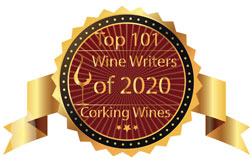red wine review is an excellent Petite Sirah, a distinct variety not to be confused with Syrah, from Napa Valley that arrived at the LCBO last weekend as part of the LCBO VINTAGES Release.
Established in 1893, Stags' Leap Winery is one of California's oldest wine estates. Their 240-acre property is situated on the watershed of the Stags Leap Palisades, nine miles north of the city of Napa, and is planted to 90 acres of vineyards. Situated in an intimate valley within the greater Napa Valley, they have a unique terroir and ideal microclimate which supports a classical standard of viticulture, land use, and winemaking. Their goal is to convey the essence of their world-class terroir from grape to glass, and to create handcrafted wines that tell an authentic story of the land on which they are grown.
The Stags' Leap name originated in the late 1880s with the founding Chase family, and is attributed to a native Wappo legend of a stag leaping to escape hunters. The mountains behind the property on the eastern side came to be known as the Stags Leap Palisades.
The Stags Leap Palisades are a rock outcropping that forms the eastern boundary of the estate and sheds debris in the form of volcanic rhyolite and tuff, which is carried to the valley floor where it mingles with the deeper subsoil made up of Bale loam formed from ancient river sediment. Topographically, the slope of the palisades and its small valley are oriented to block early morning sun, retain afternoon heat, and funnel cooler marine air coming from the San Pablo Bay to the south. The sheer volume of rock has a direct impact on the local climate of the estate as the rock face of the palisades gives off stored warmth after sunset, radiating down over the entire ranch. Moreover, the high incidence of rock in the soil holds the heat of the sun into the early twilight hours, and then loses it rapidly, effectively slowing and prolonging the ripening process. With Napa Valley's long growing season combined with the accentuated warmth and cooling of the Stags Leap District, the result is an ideal balance of acid and sugar in the fruit that also gives the grapes more time to mature and develop.
This Petite Sirah is actually a blend that includes small amounts of Syrah, Grenache, and other Rhône varieties. The grapes that make up the backbone of this wine come from the estate's vineyards which have deep, rocky soils, while other carefully selected fruit also comes from Calistoga and St. Helena in the north, and Oakville, Oak Knoll and Coombsville in the south, as well as from their own Stags Leap District. Petite Sirah is a varietal that is enhanced by the deliberate diversity of their vineyard sites.
It was vinified by Winemaker Christophe Paubert using the same, time-honoured techniques - simple and traditional - that have made Petite Sirah one of the winery's staples, thereby showing the uniqueness of the Petite Sirah fruit. It underwent a relatively short maceration and fermentation, and was aged for approximately 15 months in mostly used American oak barrels.
The 2018 growing season in Napa Valley was stunning and near-perfect with good winter rains, mild spring weather, and steady temperatures throughout that allowed for even flowering and bud break. These ideal growing conditions were followed by a cool, even, and slow-paced harvest, which allowed Stags' Leap to vinify wines at a gentle pace. The result is that the wines of 2018 are of very high quality with lower alcohol, concentrated flavours, colour, and excellent acidity. Let's see how this 2018 Petite Sirah from Napa Valley is tasting tonight...
Primarily Petite Sirah with a small amount of Syrah, Grenache, and other Rhône varieties completing the blend. Elegantly perfumed aromas of black and blue berry, dark plum, peppery spice, and cocoa, with some wood spice and reductive notes rise out of the glass. It's full-bodied and well-structured on the palate with juicy, ripe black and blue fruit, pepper, spices, and cocoa flavours with touches of smoky mineral and black raspberry adding further complexity. Acids are fresh, vibrant, and juicy, while the firm tannins are structured and grainy. Nicely balanced throughout with savoury, smoky mineral, and cocoa notes lingering on the very long finish. Enjoyable now, but will be better in a few years. Drink over the next 15 years. Highly recommended buy! Score: 93 pts
Other excellent wines by Stags' Leap Winery are available at the LCBO and through their Agent - Mark Anthony Wine & Spirits.
Established in 1893, Stags' Leap Winery is one of California's oldest wine estates. Their 240-acre property is situated on the watershed of the Stags Leap Palisades, nine miles north of the city of Napa, and is planted to 90 acres of vineyards. Situated in an intimate valley within the greater Napa Valley, they have a unique terroir and ideal microclimate which supports a classical standard of viticulture, land use, and winemaking. Their goal is to convey the essence of their world-class terroir from grape to glass, and to create handcrafted wines that tell an authentic story of the land on which they are grown.
The Stags' Leap name originated in the late 1880s with the founding Chase family, and is attributed to a native Wappo legend of a stag leaping to escape hunters. The mountains behind the property on the eastern side came to be known as the Stags Leap Palisades.
The Stags Leap Palisades are a rock outcropping that forms the eastern boundary of the estate and sheds debris in the form of volcanic rhyolite and tuff, which is carried to the valley floor where it mingles with the deeper subsoil made up of Bale loam formed from ancient river sediment. Topographically, the slope of the palisades and its small valley are oriented to block early morning sun, retain afternoon heat, and funnel cooler marine air coming from the San Pablo Bay to the south. The sheer volume of rock has a direct impact on the local climate of the estate as the rock face of the palisades gives off stored warmth after sunset, radiating down over the entire ranch. Moreover, the high incidence of rock in the soil holds the heat of the sun into the early twilight hours, and then loses it rapidly, effectively slowing and prolonging the ripening process. With Napa Valley's long growing season combined with the accentuated warmth and cooling of the Stags Leap District, the result is an ideal balance of acid and sugar in the fruit that also gives the grapes more time to mature and develop.
This Petite Sirah is actually a blend that includes small amounts of Syrah, Grenache, and other Rhône varieties. The grapes that make up the backbone of this wine come from the estate's vineyards which have deep, rocky soils, while other carefully selected fruit also comes from Calistoga and St. Helena in the north, and Oakville, Oak Knoll and Coombsville in the south, as well as from their own Stags Leap District. Petite Sirah is a varietal that is enhanced by the deliberate diversity of their vineyard sites.
It was vinified by Winemaker Christophe Paubert using the same, time-honoured techniques - simple and traditional - that have made Petite Sirah one of the winery's staples, thereby showing the uniqueness of the Petite Sirah fruit. It underwent a relatively short maceration and fermentation, and was aged for approximately 15 months in mostly used American oak barrels.
The 2018 growing season in Napa Valley was stunning and near-perfect with good winter rains, mild spring weather, and steady temperatures throughout that allowed for even flowering and bud break. These ideal growing conditions were followed by a cool, even, and slow-paced harvest, which allowed Stags' Leap to vinify wines at a gentle pace. The result is that the wines of 2018 are of very high quality with lower alcohol, concentrated flavours, colour, and excellent acidity. Let's see how this 2018 Petite Sirah from Napa Valley is tasting tonight...
Tasting Note:
STAGS' LEAP WINERY PETITE SIRAH 2018 - Napa Valley, California, USA (#590356) (XD) - $60.95Primarily Petite Sirah with a small amount of Syrah, Grenache, and other Rhône varieties completing the blend. Elegantly perfumed aromas of black and blue berry, dark plum, peppery spice, and cocoa, with some wood spice and reductive notes rise out of the glass. It's full-bodied and well-structured on the palate with juicy, ripe black and blue fruit, pepper, spices, and cocoa flavours with touches of smoky mineral and black raspberry adding further complexity. Acids are fresh, vibrant, and juicy, while the firm tannins are structured and grainy. Nicely balanced throughout with savoury, smoky mineral, and cocoa notes lingering on the very long finish. Enjoyable now, but will be better in a few years. Drink over the next 15 years. Highly recommended buy! Score: 93 pts
Other excellent wines by Stags' Leap Winery are available at the LCBO and through their Agent - Mark Anthony Wine & Spirits.






























